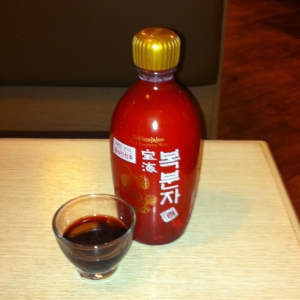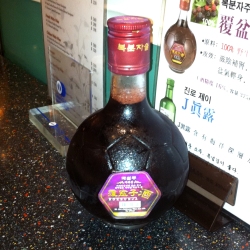(serves 6)
Chicken Ginseng Soup, the deluxe version of chicken noodle soup, is one of my Korean favourites. It’s a sumptuous soup made from young chicken and ginseng, a root greatly prized in Asia for its health-promoting properties. The third ingredient is glutinous rice, which has the magical property of transforming the earthy tones of ginseng into a delectable flavour even while it adds body to the soup. Together they make a really tasty nutritious broth, especially for someone who is under the weather.
Ingredients
- Young Chicken (i.e. small)
- Ginseng slices (1/4 cup)
- Raw Glutinous Rice (3/4 cup)
- Dried Red Dates (15)
- Garlic (1 bulb = 12 cloves)
- Chicken Stock Cubes (2)
- Coriander Seed Powder
Preparation
For the general theory of preparing East Asian soups, please refer to my Chinese Consommé post. If you are not familiar with glutinous rice, refer to my White Rice page.
- Rinse 3/4 cup of glutinous rice a few times.
- Open up a bulb of garlic and peel each clove after cutting off the tips. You should end up with a 12-15 whole cloves of garlic .
- Spoon the rinsed rice into the body cavity through the rear of the chicken. Cut a small opening in the chicken below the neck to allow free flow of water into the body cavity from the front.
- Place the chicken in a tall pot which is slightly larger than the chicken. This way, the entire chicken can be covered without using too much water.
- In a kettle, boil 2 litres of water. Pour this into the pot (with the chicken in it). After a minute drain away the water.
- Boil another 2 litres of water in the kettle and add this to the pot, followed by 2 chicken stock cubes, 1t salt and 1t coriander seed powder. Simmer, semi-covered, for 20 minutes.
- After the first simmer, add 15 dried red dates, the garlic cloves and 1/4 cup of ginseng chips. Simmer on low for a further hour, topping up with hot water as necessary. Keep the chicken totally submerged until the last 15 minutes.
- After the hour is up, leave the soup to cool for a few hours on the stove, with the cover on. When the soup has cooled, skim off some of the fat on the surface.
- When its time to serve the soup, bring the soup to a boil for 5 min. Some people like to add chopped spring onions at this stage, but i think its more for garnishing than taste. Depending on your tastes, you should need to add a further 1 to 2 t of salt before serving. Add this incrementally, checking the soup each time.
Notes

- Do not use any other type of rice. Glutinous rice is known for the integrity of its kernel and other types of white rice would simply disintegrate long before the soup is done. That being said, do not over boil the soup or even glutinous rice will break up. Besides, no other type of rice has the same complimentary chemical interaction with ginseng.
- The timing for this recipe assumes the glutinous rice is inside the chicken. If you decide to use parts instead of a whole chicken, reduce the amount of rice to 1/2 a cup and add it to the pot 20 minutes after you the garlic, dates and ginseng instead. Rice cooks much faster outside the chicken. Be forewarned, the soup will also be more murky.
- Depending on the size of your chicken you can use more or less rice, but you don’t want to stuff the chicken too fully. Once the rice expands, access to the boiling soup may be impeded for the rice right in the center.
- Just use American ginseng, it is cheaper. Forget the mumbo jumbo about the medicinal differences between Asian and American Ginseng. My recipe uses ginseng slices (again because it is cheaper) but you can use an equivalent amount of whole ginseng roots (pictured) if you like. In that case add the ginseng right at the beginning.
- Why didn’t we just add all the ingredients at the beginning? Because the garlic and ginseng (slices) would become too mushy before the rice is cooked.
- Why do we need to add the first lot of boiling water? Why do we need to let the soup cool before reboiling? You were supposed to refer to my Chinese Consommé post.



